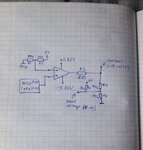Glebiys
Junior Member level 2
Hello all,
Task: to make a square wave with a frequency of 1 kHz in the voltage range (-12V - + 12V), using a PWM signal with voltage (0V-5V).
Circuit:

Originally LM258WYDT (ST) was used as an operational amplifier, it did not heat up, but since it was not from the Rail-to-Rail series, there was a 1.5V drop at the output, which did not allow us to give out a voltage close to 12V. So I decided to switch to Rail-to-Rail, for these purposes I found OP284FSZ-REEL7 (AnalogDevices). After replacing with this amplifier, the value of the output voltage became close to 12V (+-11.85V), but the operational amplifier began to heat up (after 5 minutes its temperature was about 45-60 degrees).
I did not find a short circuit, but noticed that at the output of the voltage divider (R1, R2), instead of 2.5V, the voltage became 4.5V. On the LM258WYDT, this voltage was 2.5V. Perhaps there are elements on this input of the operational amplifier that should lift it?
Unfortunately, at the moment I do not have an oscilloscope and I can not see the output signal.
My suspicions:
Task: to make a square wave with a frequency of 1 kHz in the voltage range (-12V - + 12V), using a PWM signal with voltage (0V-5V).
Circuit:

Originally LM258WYDT (ST) was used as an operational amplifier, it did not heat up, but since it was not from the Rail-to-Rail series, there was a 1.5V drop at the output, which did not allow us to give out a voltage close to 12V. So I decided to switch to Rail-to-Rail, for these purposes I found OP284FSZ-REEL7 (AnalogDevices). After replacing with this amplifier, the value of the output voltage became close to 12V (+-11.85V), but the operational amplifier began to heat up (after 5 minutes its temperature was about 45-60 degrees).
I did not find a short circuit, but noticed that at the output of the voltage divider (R1, R2), instead of 2.5V, the voltage became 4.5V. On the LM258WYDT, this voltage was 2.5V. Perhaps there are elements on this input of the operational amplifier that should lift it?
Unfortunately, at the moment I do not have an oscilloscope and I can not see the output signal.
My suspicions:
- The amplifier is not designed for such a load or, conversely, it is not enough for it, and it begins to oscillate.
- Is this an accurate amplifier, perhaps additional elements are needed for its operation?
- The amplifier is damaged.